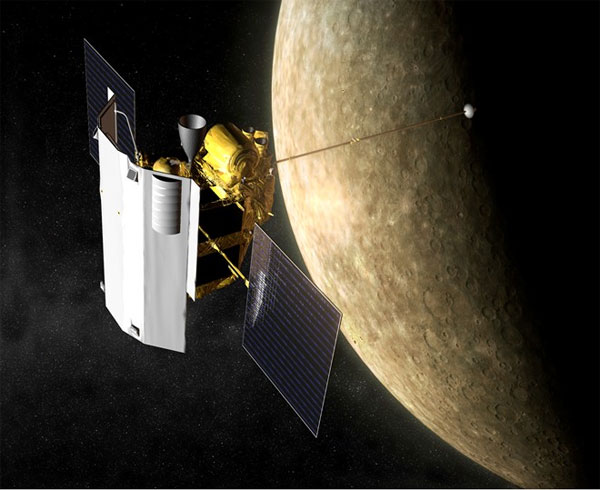NASA spacecraft rushes down to Mercury's surface
The US Aeronautics Agency (NASA) said the Messenger probe crashed into Mercury's surface because it ran out of fuel after 11 years of operation.
The Messenger probe rushes down Mercury
The Center controls the mission of Mercury exploration at Johns Hopkins University's Physical Laboratory and Application, confirming that Messenger crashed at 3h26 on April 30 (7:26 GMT).
According to NASA, the ship collided with Mercury's surface at a speed of 14,000km / h and created a hole of 16m in diameter. The telescope system on earth cannot observe the collision because it happened on the other side of Mercury, CNN reported.

Simulation of NASA Messenger probe.(Photo: CNN)
Messenger is an acronym for Mercury Surface , space, geo-chemistry and scope. It was launched into space in 2004 and moved for 6 1/2 years to orbit Mercury on March 18, 2011. This is the first spacecraft to be responsible for observing the planet right next to the Sun.
Scientists say Messenger still works well when it comes to Mercury. However, the ship ran out of fuel after an 8-billion-kilometer journey along the four years of scrutinizing the planet closest to the Sun.
Experts could not find a solution to save the ship, so they decided to let it break down and celebrate because Messenger had successfully completed the assigned task.
For more than 4 years, Messenger provides valuable data and thousands of photos about Mercury. One of the biggest discoveries is that the giant ice block in the polar region is not illuminated by the sun. If Washington, USA is covered, the ice will be 2m thick.
Although it has ended, scientists will take years to analyze the data the ship sends. It is the key to helping people better understand the smallest planet in the Solar System.
- NASA acknowledges spacecraft hit by UFOs
- The surface of Mercury is revealed by the image of the spacecraft
- NASA's $ 3.3 billion spacecraft is about to commit suicide on Saturn
- NASA spacecraft approaches the ancient Bennu planet
- NASA broke into the moment the InSight probe landed on Mars successfully
- The NASA ship found robots landing on Mars
- NASA connected with the spacecraft that had lost its signal two years ago
- NASA tested a UFO-like spacecraft
- Our Earth has a 'Broken Moon'
- The jagged surface of Pluto
- ESA intends for spacecraft to crash into comets?
- NASA is about to launch Orion spacecraft
 Van Allen's belt and evidence that the Apollo 11 mission to the Moon was myth
Van Allen's belt and evidence that the Apollo 11 mission to the Moon was myth The levels of civilization in the universe (Kardashev scale)
The levels of civilization in the universe (Kardashev scale) Today Mars, the sun and the Earth are aligned
Today Mars, the sun and the Earth are aligned The Amazon owner announced a secret plan to build a space base for thousands of people
The Amazon owner announced a secret plan to build a space base for thousands of people